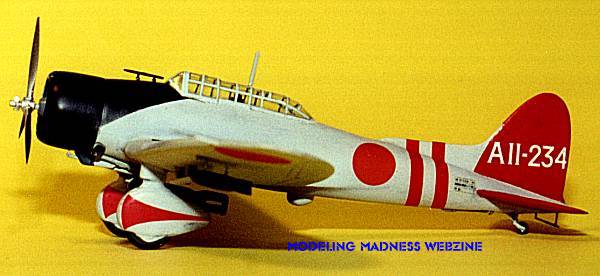
Fujimi 1/72 Aichi D3A-1 “Val”
PRICE: $12.50 (in 1991)
KIT NUMBER: F7
DECALS: 2 Versions-- One from the Yokosuta Kokutai, c.1940 and one flying off of IJNS Akagi
OVERALL IMPRESSION: Good
DATE OF REVIEW: March 30, 1998
REVIEWED BY: Drew Nix

The Aichi D3A-1 (Allied code name “Val”) was the premiere carrier-born dive bomber at the outbreak of World II and remained so until the Battle of Midway in June of 1942. Although supposedly replaced by the “Judy”, the truth is the Val remained in service with the Japanese Navy until the bitter end. Already obsolete when the war broke out, with its spatted wheels and greenhouse cockpit, it was still an outstanding dive-bomber if it had adequate fighter protection. As the war progressed and the Japanese Navy lost its carrier fleets, the Val was relegated to training duties until the end of the war when it was used as a Kamikaze.
Fujimi’s 72nd scale Val was released about 10 years ago. The box art shows a Val cruising over the beaches of Hawaii. Molded in a hard, light gray plastic, the kit features finely recessed panel lines. Like their Phantom series, Fujimi chose to mold this kit in a modular way so that later versions of the Val could be sold separately. Whatever happened to “choice of three versions using the enclosed parts”?
Starting with the cockpit, the word that comes to mind is “spartan”. You get the cockpit floor, two seats, a pilot’s control stick, and a flat instrument panel. A decal is provided to represent the instruments. There is no side console detail or any other representations of cockpit fixtures, except a box structure on a shelf between the pilot and observer that represents a radio. Since Fujimi only provides the canopy in the closed position, and since it has a lot of framing, the lack of interior detail is not TOO noticeable. This, however, was a disappointment as after having built their excellent F7U-3 Cutlass and F-86F Sabre in this scale, I had come to expect a lot of interior detail such as found in those kits.

The kit went together fairly easily but the fit was made more complicated by the modular construction of the molding. As a result, putty was required at almost every seam, but not copious amounts. Due to Fujimi’s use of a hard plastic, lost panel lines were hard to rescribe. The cradle/trapeze for the main 250kg bomb was “fiddly” to construct and the one in my kit broke when I cut it from the sprue. The 250 kg bomb and the two 60kg bombs represented on this version have positive locating slots in them that, while useful in attaching them, are not very realistic looking. The arming propeller on the nose of the 250kg bomb broke off during construction and was replaced by thin brass wire, unpainted.
The exhaust stacks appear to stick out too far from the cowling. The antenna attaches to the canopy but is way too thick in scale. If the real item had been this thick, it would have been at least 3 feet wide! The main gear wheels are molded in with the spats making painting difficult.
The canopy framing was difficult to mask and paint. After several attempts using various masking techniques, I painted some clear decal paper the interior color followed by the exterior color, cut them to size and used the strips to represent the framing. Decals from the Aeromaster Tora, Tora, Tora sheet were used to represent a red-tailed Val from the Kaga in late 1940. They went on beautifully, except for the two red stripes around the fuselage (I have difficulty with stripes going around a compound curve, never seeming to get them right! Therefore, stripes are painted and masked where possible.) Aeromaster decals are unreservedly recommended.
When completed, you have a good representation of the premiere Japanese carrier-based dive bomber of early World War II. Due to the complex modular construction and the many small, fragile parts; this kit is not recommended for the novice builder. That said, it is probably the best model of the Val in this scale.